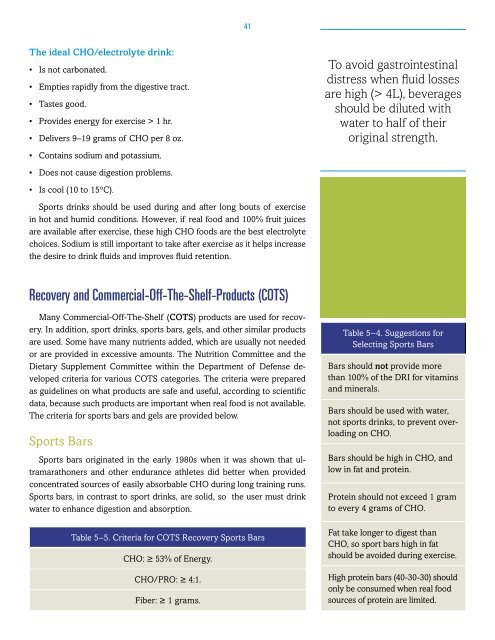special-operations-nutrition-guide
special-operations-nutrition-guide
special-operations-nutrition-guide
Create successful ePaper yourself
Turn your PDF publications into a flip-book with our unique Google optimized e-Paper software.
41<br />
The ideal CHO/electrolyte drink:<br />
• Is not carbonated.<br />
• Empties rapidly from the digestive tract.<br />
• Tastes good.<br />
• Provides energy for exercise > 1 hr.<br />
• Delivers 9–19 grams of CHO per 8 oz.<br />
• Contains sodium and potassium.<br />
To avoid gastrointestinal<br />
distress when fluid losses<br />
are high (> 4L), beverages<br />
should be diluted with<br />
water to half of their<br />
original strength.<br />
• Does not cause digestion problems.<br />
• Is cool (10 to 15°C).<br />
Sports drinks should be used during and after long bouts of exercise<br />
in hot and humid conditions. However, if real food and 100% fruit juices<br />
are available after exercise, these high CHO foods are the best electrolyte<br />
choices. Sodium is still important to take after exercise as it helps increase<br />
the desire to drink fluids and improves fluid retention.<br />
Recovery and Commercial-Off-The-Shelf-Products (COTS)<br />
Many Commercial-Off-The-Shelf (COTS) products are used for recovery.<br />
In addition, sport drinks, sports bars, gels, and other similar products<br />
are used. Some have many nutrients added, which are usually not needed<br />
or are provided in excessive amounts. The Nutrition Committee and the<br />
Dietary Supplement Committee within the Department of Defense developed<br />
criteria for various COTS categories. The criteria were prepared<br />
as <strong>guide</strong>lines on what products are safe and useful, according to scientific<br />
data, because such products are important when real food is not available.<br />
The criteria for sports bars and gels are provided below.<br />
Sports Bars<br />
Sports bars originated in the early 1980s when it was shown that ultramarathoners<br />
and other endurance athletes did better when provided<br />
concentrated sources of easily absorbable CHO during long training runs.<br />
Sports bars, in contrast to sport drinks, are solid, so the user must drink<br />
water to enhance digestion and absorption.<br />
Table 5–5. Criteria for COTS Recovery Sports Bars<br />
CHO: ≥ 53% of Energy.<br />
CHO/PRO: ≥ 4:1.<br />
Fiber: ≥ 1 grams.<br />
Table 5–4. Suggestions for<br />
Selecting Sports Bars<br />
Bars should not provide more<br />
than 100% of the DRI for vitamins<br />
and minerals.<br />
Bars should be used with water,<br />
not sports drinks, to prevent overloading<br />
on CHO.<br />
Bars should be high in CHO, and<br />
low in fat and protein.<br />
Protein should not exceed 1 gram<br />
to every 4 grams of CHO.<br />
Fat take longer to digest than<br />
CHO, so sport bars high in fat<br />
should be avoided during exercise.<br />
High protein bars (40-30-30) should<br />
only be consumed when real food<br />
sources of protein are limited.


